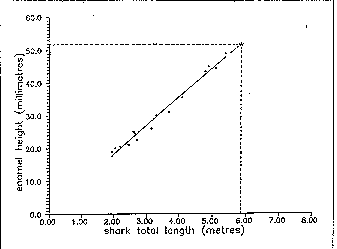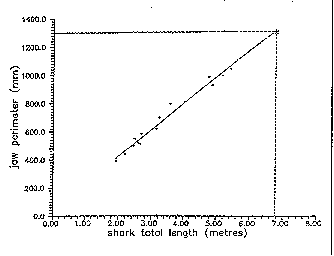|
CARCHARODON CARCHARIAS (LINNAEUS); WAS PETER RISELEY'S WHITE POINTER A WORLD RECORD? By Michael Cappo, Research Scientist Austr. Inst. of Mar. Science |
|
|
The maximum size and age attained by the white pointer shark (Carcharodon carcharias) have been the subject of much speculation in recent times. The Jaws movies, a resurgence in gamefishing activity (Starling 1987), and the occasional attacks on humans, have aroused interest and debate concerning the large white pointer sharks in our State waters. Some local authorities have reported that populations have declined in number in certain areas, such as Dangerous Reef, and have sought protective measures for conservation of the species. Others, including fishermen involved in the southern shark fishery, are not aware of such a decline. Despite this interest, the basic biology of the white pointer is not well understood. There is a lack of information on the catches, abundance, movements, growth, age and reproductive biology of these sharks; such information is vital for any assessment of the species' current status (Cailliet et al. 1985, Compagno 1984, Ellis 1987, Stevens 1986). In South Australia, the remote locations of capture and sheer bulk of the sharks, make accurate measurements difficult, and hamper the dispatch or freezer storage of specimens for further examination by scientific authorities. After the jaws are removed shark carcasses are dumped, and valuable opportunities for data collection are lost. Since the introduction of bottom-set gill nets into the southern shark fishery, many fishermen have taken white pointers. They enter the nets, sometimes to feed on the catch, and become entangled in the gear. Whether successful or not in their struggles for freedom, the large sharks cause great damage to the nets, and are regarded as pests. On 1 April 1987, Peter Riseley set gill nets at 59 to 63 m (33 to 35 fathoms) depth some 40 nm SSE of Cape Hart, Kangaroo Island (36'45'S; 138'18'E). A large female white pointer was entangled in the nets but was too large to be brought aboard; therefore, no accurate details of length, reproductive state or stomach contents were collected. Instead, it was tied alongside the boat and the head removed. From measurements of the distance between the fore and aft bollards to which the shark was tied off, Peter estimated a total length of 6.9 m (23 feet). He considered this to be an underestimate, as the shark was bowed down in the water by its bulk between head and tail (P. Riseley pers. comm., April 1987). The largest white pointer reliably measured was a 6.0 m (19.5 feet) individual from Ledge Point, Western Australia (Randall 1987). For a century the maximum length attributed to the white pointer was 11. 1 m (36.5 feet), for a specimen from Port Fairy Victoria. Randall (1973) disputed the size of this individual by comparing the dimensions of its preserved jaws and teeth with those from sharks of verified length. He found that the Port Fairy shark was of the order of 5 m (17 feet) in length and suggested that a mistake had been made in the original record, in 1870, of the shark's length. More recent reports claimed lengths of 6.4 m (21 feet) to 11.3 m (37 feet) for white pointers landed in Cuba and Canada. Using the same comparisons, where possible, and photographs, Randall (1987) thoroughly refuted these further 'records'. He concluded that " . . . although it is probable that C. carcharias exceeds a length of 6.1 m (20 feet), irrefutable evidence of such a length has yet to be presented". |
|
|
I measured the teeth and jaws of Peter Riseley's shark to make some comparisons with Randall's (1973) data set. He plotted the relation between enamel height of the largest tooth in the upper jaw with total length, and the relation between perimeter of the upper jaw and total length. Unfortunately, some of the original data used to prepare the graphs have been lost. For the sake of comparison, I estimated the original data points by reading directly from photographic enlargements of Randall's (1973) graphs. These data are reproduced in Figures 1 and 2, with an extrapolation by eye to include my measurements of the same dimension from Peter Riseley's specimen. These and other measurements are listed in Table 1. |
Figure 1. Relation of the enamel height of the largest tooth in the upper jaw to total length for the white pointer shark. The enamel height was measured from the tip of the tooth vertically to a line connecting the two most ventral extensions of the enamel (data redrawn from Randall 1973, copyright 1973 by the American Association for the Advancement of Science). *= Peter Riseley's shark. Figure 2. Relation of the perimeter of the upper jaw to total length for the white pointer shark. Perimeter measured by laying a string over the curvature of the upper jaw, just above the base of the teeth, from one extreme corner of the mouth to the other (data redrawn from Randall 1973, copyright, 1973 by the American Association for the Advancement of Science). *= Peter Riseley's shark. |
|
Table 1. Measurements of teeth and upper jaw taken from Peter Riseley's white pointer, according to Randall's (1973) methods. Perimeter of upper jaw 1297 mm Enamel height of largest tooth 51.6 mm Jaw width (inner corner to inner corner) 829 mm Jaw height (upper to lower symph. at tooth bases) 706 mm Enamel heights of six upper lateral teeth Left 51.6, 44.6, 34.0, 41.6, 43.5, 40.9 mm Right 50.1, 49.6, 34.4, 41.6, 43.6, 42.9 mm |
|
|
At first glance the teeth of this shark seem remarkably small in relation to the wide expanse of the jaws, especially in comparison with jaws of smaller specimens. Tooth shape is unusual in several instances, being spindle-shaped rather than broadly triangular. Consequently, extrapolations from Randall's (1973) plots give two different estimates of length. Using upper jaw perimeter, I estimate the shark's total length at around 6.8 m (22.6 feet); using enamel height gives a lesser estimate of 5.8 m (19.3 feet). These extrapolations were made upon the assumption that jaw perimeter and enamel height both vary in a linear fashion with increasing total length. In the case of white pointer teeth, this may not be so. Juveniles, below 2 m long, are known to have small lateral cusplets, with some smooth edged or only partially serrated teeth (Compagno, 1984). There is evidence also that tooth shape changes with shark size, perhaps associated with a change in diet to include marine mammals (Ian Gordon pers. comm., 1988). Perhaps the tooth shape and growth of very large specimens changes further, or stops, while body size increases. Shrinkage of these jaws, during the drying process has caused recent measurements of upper jaw perimeter to be smaller by some 10 per cent: this factor is presently under study by Ian Gordon of Australia's Underwater World in Manly, New South Wales. My measurements were taken within one month of the beginning of the drying process, but it is unknown to what degree they had shrunk. Compagno (1984) presented a length-weight power curve for the white shark total length pointer shark (98 specimens, mostly from California, and with a length range from 127 to 554 cm) as follows:
Applying this formula to an estimate of 7 m for Peter Riseley's shark, gives an estimated weight of 3725 kilograms. However, total weight varies greatly between sharks of equivalent length, depending on condition and stomach contents. It is therefore possible that an official measurement of the dimensions of Peter Riseley's shark would have produced a new record for the white pointer. A popular view of white pointer longevity attributes an age of a century or more to large individuals (Starling, 1987). There is no scientific basis for such a belief. Cailliet et al. (1985) studied the growth and age of twenty-one specimens from California. They counted bands on segments of the 'backbone' (vertebral centra) to age specimens from 129 cm (4.3 feet) to 507 cm (16.9 feet) in length. They estimated an age of fifteen years for a white pointer of 494 cm (16.5 feet) in total length, and an upper limit of maximum attainable size at 764 cm (25.4 feet). They tentatively calculate that such a shark could be 27 years old. However, their sample was small, and did not contain larger, older individuals; and the ageing technique has not been validated by tagging studies or other independent means. They conclude that the maximum age attained by the white pointer still remains unknown. The reproductive biology of the white pointer shark also is poorly known. The scientific literature does not contain a single reliable record of a pregnant individual from anywhere in the world (Stevens 1986). Efforts should be made to obtain the most accurate biological information from captures of all white pointers. In the case of small specimens (less than 1.5 m (5 feet)) the whole shark should be frozen for further scientific examination. In the event that a pregnant shark is caught, the embryos (or pups) should not be disturbed, but left in position within the mother so that the method of reproduction can be studied. Dr John Stevens should be contacted immediately. Failing this, every effort should be made to take the whole uterus, and its contents of young sharks, to a Fisheries Department office, the South Australian Museum or a freezer. For all white pointers too big to retain as a whole, endeavours should be made to land them, and arrange for a fisheries or museum officer to promptly examine them. Failing this, the following procedures should be followed.
Dr John Stevens or Dr Peter Last CSIRO Marine Laboratories Division of Fisheries Research GPO Box 1538 Hobart Tasmania 7001 Tel: (002) 20 6222 John Glover Senior Curator of Fishes South Australian Museum North Terrace Adelaide South Australia 5000 Tel: (08) 223 8890 Ian Gordon Australia's Underwater World West Esplanade Manly New South Wales 2095 Tel: (02) 949 2644 They will arrange for the examination of vertebrae, pregnant sharks and jaws. Any efforts fishermen make in collecting accurate biological data will lead to a better understanding of this notorious, but poorly known shark. Cailliet, G. M., Natanson, L.J., Welden, B. A. and Ebert, D. A. (1985). Preliminary studies on the age and growth of the white shark, Carcharodon carcharias, using vertebral bands. Mem. S. Calif. Acad. Sci. 9, 49-60. Compagno, L. J. V. (1984). Sharks of the world. An annotated and illustrated catalogue of shark species known to date. FAO Fisheries Synopsis No. 125, Vol. 4, Part 1. Ellis, R. (1987). The great white shark. Underwater Naturalist 16(3), 3-12. Randall. J. E. (1973). Size of the great white shark (Carcharodon). Science 181, 169-170. Randall, J. E. ( 1987). Refutation of lengths of' 11.3, 9.0 and 6.4 m attributed to the white shark, Carcharodon carcharias. Calif. Fish and Game 73(3): 163-168. Starling. S, (1981). Return of the great white. Fishing World. August, p. 39. Stevens, J.D (1986). Information needed on pregnant white sharks. Aust. Fisheries August, p 16. |
|

